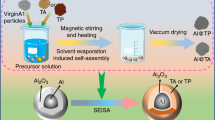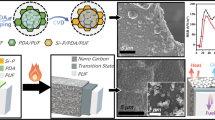Abstract
Flame-retardant glass fiber-reinforced PA6 (GFPA6) composites were prepared by incorporating the mixture of piperazine pyrophosphate (PAPP) and aluminum hypophosphite (AHP) into GFPA6. From the results of UL-94 test, limiting oxygen index (LOI) and microscale combustion calorimetry (MCC) tests, the as-obtained composites exhibited significantly enhanced flame retardancy including higher LOI values, better UL94 rating (V-0 for 18.0 mass% PAPP/AHP mixture), and decreased peak heat release rate and total heat release. And PA6-4 with a 4/1 mass ratio of PAPP to AHP reached the highest LOI value. The influence of PAPP/AHP on the decomposition pathway of GFPA6 was discussed based on TG and TG-FTIR analysis. The interaction between PAPP/AHP and GFPA6 altered the decomposition pathway of GFPA6 resulting in the formation of compact char layer, high thermal stability within high-temperature region, and weak intensities of a variety of pyrolysis gas products. Meanwhile, the thermomechanical property data revealed the storage modulus of samples were increased with increasing PAPP/AHP content, whereas the glass transition temperatures were reduced gradually. Moreover, the results of scanning electron microscope illustrated that the introduction of PAPP/AHP mixture can promote the formation of compact char layer and change the surface element composition of the char.














Similar content being viewed by others
References
Chen YH, Wang Q. Preparation, properties and characterizations of halogen-free nitrogen-phosphorous flame-retarded glass fiber reinforced polyamide 6 composite. Polym Degrad Stab. 2006;91(9):2003–13.
Harintharavimal B, Azman H. On the use of magnesium hydroxide towards halogen-free flame-retarded polyamide-6/polypropylene blends. Polym Degrad Stab. 2012;97(8):1447–57.
Monti M, Tsampas SA, Fernberg SP. Fire reaction of nanoclay-doped PA6 composites reinforced with continuous glass fibers and produced by commingling technique. Poly Degrad Stab. 2015;121:1–10.
Malchev PG, Vos GD, Picken SJ. Mechanical and fracture properties of ternary PE/GFPA6 composites. Compos Sci Technol. 2010;70(5):734–42.
Bernasconi A, Davoli P, Rossin D. Effect of reprocessing on the fatigue strength of a fibre glass reinforced polyamide. Compos Part Anal Appl Sci Manuf. 2007;38(3):710–8.
Tai QL, Richard KK. Iron-montmorillonite and zinc borate as synergistic agents in flame-retardant glass fiber reinforced polyamide 6 composites in combination with melamine polyphosphate. Compos Part Anal Appl Sci Manuf. 2012;43(3):415–22.
Aleksandra B, Timea S, Lea B. Bridged DOPO derivatives as flame retardants for PA6. Polym Degrad Stab. 2014;107:158–65.
Gijsman P, Steenbakkers R. Differences in the flame retardant mechanism of melamine cyanurate in polyamide 6 and polyamide 66. Polym Degrad Stab. 2002;78(2):219–24.
Hu Z, Chen L. Flame retardant of glass-fibre-reinforced polyamide 6 by a metal salt of alkylphosphinic acid. Polym Degrad Stab. 2011;96(9):1538–45.
Klatt M, Leutner B. Flame-retardant polyester molding compositions containing flame retardant nitrogen compounds and diphosphinates. U.S. Patent. 2003;503(6):969.
Zhao B, Li C. Aluminum hypophosphite versus Alkyl-substituted phosphinate in polyamide 6: flame retardancy, thermal degradation and pyrolysis behavior. Ind Eng Chem Res. 2006;45:8610–6.
Yang W, Song L. Enhancement of fire retardancy performance of glass-fibre reinforced poly (ethylene terephthalate) composites with the incorporation of aluminum hypophosphite and melamine cyanurate. Compos Part B Eng. 2011;42(5):1057–65.
Wu NJ, Li XT. Flame retardancy and synergistic flame retardant mechanisms of acrylonitrile–butadiene–styrene composites based on aluminum hypophosphite. Polym Degrad Stab. 2014;105:265–76.
Ge H, Tang G. Aluminum hypophosphite microencapsulated to improve its safety and application to flame retardant polyamide 6. J Hazar Mat. 2015;294:186–94.
Ulrike B, Bernhard S. Flame retardancy mechanisms of aluminium phosphinate in combination with melamine polyphosphate and zinc borate in glass-fibre reinforced polyamide 66. Polym Degrad Stab. 2007;92(8):1528–45.
Jenewein E, Kleiner HJ. Synergistic flame protection agent combination for thermoplastic polymers. U.S. Patent. 2002;365(6):071.
Chen T, Hao DM (2012) The preparation of piperazine pyrophosphate. China Patent. CN102304100A. vol 1.
Zhan ZS, Xu MJ. Synergistic effects of sepiolite on the flame retardant properties and thermal degradation behaviors of polyamide 66/aluminum diethylphosphinate composites. Polym Degrad Stab. 2015;117:66–74.
Nie SB, Peng C, Yuan SJ, Zhang MX. Thermal and flame retardant properties of novel intumescent flame retardant polypropylene composites. J Therm Anal Calorim. 2013;113:865–71.
Bakirtzis D, Ramani A. Simplified structure of the condensed phase of fire retarded PA6 nanocomposites in TG as related flammability. Fire Saf J. 2014;69:69–75.
Chen J, Liu SM. Synthesis, application and flame retardancy mechanism of a novel flame retardant containing silicon and caged bicyclic phosphate for polyamide 6. Polym Degrad Stab. 2011;96(8):1508–15.
Takashi K, Richard H. Flame retardant mechanism of polyamide 6–clay nanocomposites. Polymer. 2004;45(3):881–91.
Lyon RE, Walters RN. Screening flame retardants for plastics using microscale combustion calorimetry. Polym Eng Sci. 2007;47(10):1501–10.
Zhang J, Silcock GWH. Study of the combustion and fire retardancy of polyacrylonitrile and its copolymers by using cone calorimetry. J Fire Sci. 1995;13:141–61.
Pramoda KP, Liu TX. Thermal degradation behavior of polyamide 6/clay nanocomposites. Polym Degrad Stab. 2003;81:47–56.
Zou H, Yi C, Wang L, Liu H, Xu W. Thermal degradation of poly(lactic acid) measured by thermogravimetry coupled to Fourier transform infrared spectroscopy. J Therm Anal Calorim. 2009;97:929–35.
Perrer B, Pawlowski KH, Schartel B. Fire retardancy mechanisms of arylphosphates in polycarbonate (PC) and PC/acrylonitrile–butadiene–styrene. J Therm Anal Calorim. 2009;97:949–58.
Hu S, Song L. Thermal properties and combustion behaviors of flame retarded epoxy acrylate with a chitosan based flame retardant containing phosphorus and acrylate Structure. J Anal Appl Pyrolysis. 2012;97:109–15.
Wang BB, Zhou KQ. Enhancement on physical properties of flame retarded ethylene-vinyl acetate copolymer/ferric pyrophosphate composites through electron beam irradiation. Compos Part B Eng. 2012;43:641–6.
Mitra SM, Atul A. Investigation of accelerated aging behaviour of high performance industrial coatings by dynamic mechanical analysis. Prog Organic Coat. 2014;77(11):1816–25.
Masoud RA, Hossein AK. Application of mean-field theory in PP/EVA blends by focusing on dynamic mechanical properties in correlation with miscibility analysis. Compos Part B Eng. 2015;79:74–82.
Mofokeng JP, Luyt AS. Dynamic mechanical properties of PLA/PHBV, PLA/PCL, PHBV/PCL blends and their nanocomposites with TiO2 as nanofiller. Thermochim Acta. 2015;613:41–53.
Zuo XL, Shao HJ. Effects of thermal-oxidative aging on the flammability and thermal-oxidative degradation kinetics of tris (tribromophenyl) cyanurate flame retardant PA6/LGF composites. Polym Degrad Stab. 2013;98(12):2774–83.
Acknowledgements
The work was financially supported by the Program for Science and Technology Talent of Shang Hai (15YF1405500) and the special development fund project of Shanghai Zhangjiang national innovation demonstration zone (201501-PT-C104-012).
Author information
Authors and Affiliations
Corresponding author
Rights and permissions
About this article
Cite this article
Xiao, X., Hu, S., Zhai, J. et al. Thermal properties and combustion behaviors of flame-retarded glass fiber-reinforced polyamide 6 with piperazine pyrophosphate and aluminum hypophosphite. J Therm Anal Calorim 125, 175–185 (2016). https://doi.org/10.1007/s10973-016-5391-0
Received:
Accepted:
Published:
Issue Date:
DOI: https://doi.org/10.1007/s10973-016-5391-0




